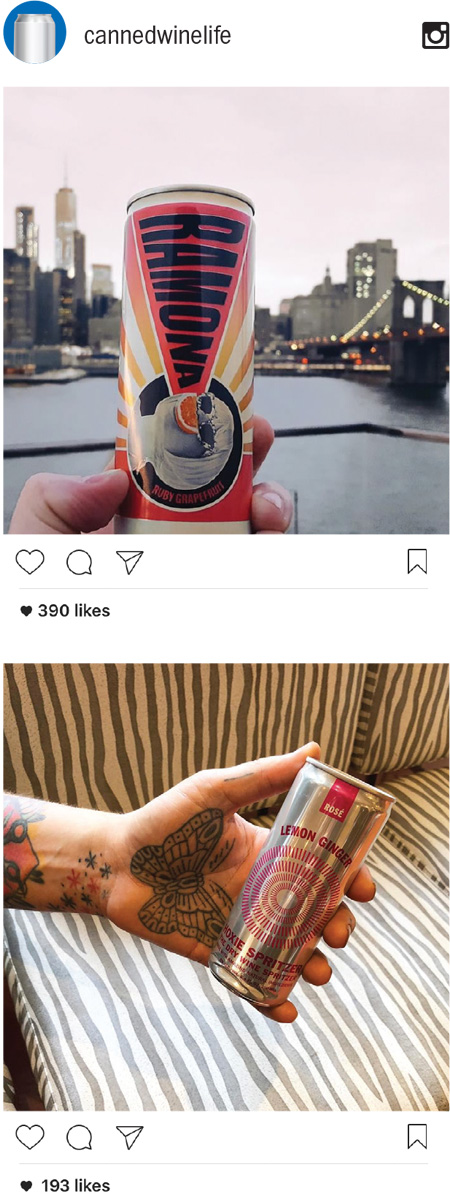In May 2017, Caitlin Suemnicht was scrolling through Instagram on her phone, checking out posts from fellow sommeliers. Suemnicht, 38, is the Chief Creative Officer at Food Fight, a group that owns and runs 19 restaurants in and around Madison, Wisconsin; their operations range from fine dining to fast-casual. The group was opening a taco spot and she stumbled on a photo of Ramona, a grapefruit wine spritzer in a can.
Ramona is the brainchild of Jordan Salcito. Launched in fall 2016, Ramona was still new to the market but gaining traction through Instagram (Salcito currently has more than 13,000 followers and frequently posts pictures of Ramona cans in various locales). Suemnicht tried it and thought that the citrusy flavor profile would go well with their tacos. So she contacted a local distributor about getting it in the state. The wine was on the list on opening day.
Salcito, 37, is the Director of Wine Special Projects for David Chang’s restaurant group, Momofuku. She created Ramona as an “alter ego,” she says, something apart from the fine wine she focuses on in her job—something to drink outdoors, or in any traditional “beer moment.”
Sensing a void in the market, she wondered, “Why wasn’t there an affordable wine option for that moment?” Indeed, the Ramona marketing material says that they are on a mission to “free wine drinkers from rules, dinner tables and bottle openers.”
But it’s not just wine coolers for hipsters that are sparking interest in canned wine. Given the packaging’s light weight, complete blocking of damaging UV rays, and the success of the craft beer movement, cans are taking wine to new audiences and places.


Josh Rosenstein, who developed Hoxie, calls his fruity, herb-infused, five-percent alcohol spritzers “sessionable.” The term comes from craft beer, where lower-alcohol offerings make it easier to drink several at one sitting.
Wine for the Instagram era
The cans are eye candy on Instagram. Rosenstein says that when it comes to wine in a can, “People just aren’t familiar with that, so they do a double take.”
Kyna Williams, marketing director of Oregon’s Union Wine Co., which sells Underwood wine in cans, says that Instagram has been vital. “Consumers love to showcase where they take the cans—we’ve seen Underwood cans on top of mountains, on chairlifts and even in the bathtub! These are definitely ‘Instagram worthy’ moments, and for us, it emphasizes the portability and efficiency of the cans—you really can take them everywhere.” Underwood is the market leader, putting out about 244,000 cases of canned wine in 2017.
No corkscrew needed
A question arises about serving canned wine: Does it merit the crystal stemware or a Solo cup?
Graham Veysey of Mancan Wine says, “You don’t need to worry about crappy plastic cups—the best vessel for drinking is right there in the palm of your hand, straight out of the can.”
“We love riding the wine-in-the-can wave,” he says. “It resonates so much because of the ease. After a day at work, go home, open the fridge: The product is consistent and it’s easy to open. We want to be the everyday go-to for anyone who wants to take the chore out of drinking wine.”
Caitlin Suemnicht, who put canned wine on the list at the taco restaurant Canteen in Madison, agrees that a large part of the appeal is the ease of use, consistency and lack of spoilage and waste.
“My only wish is that more cans were sold in 187-milliliter sizes,” she says. “Sometimes a twelve-ounce can is a lot to commit to as a single person, at lunch, say.”
But one good thing about liquor laws in Madison is that unopened cans purchased in a restaurant can also be taken to go. And what’s more portable than a can?
This story was featured in W&S June 2018.
This story appears in the print issue of June 2018.
Like what you read? Subscribe today.















